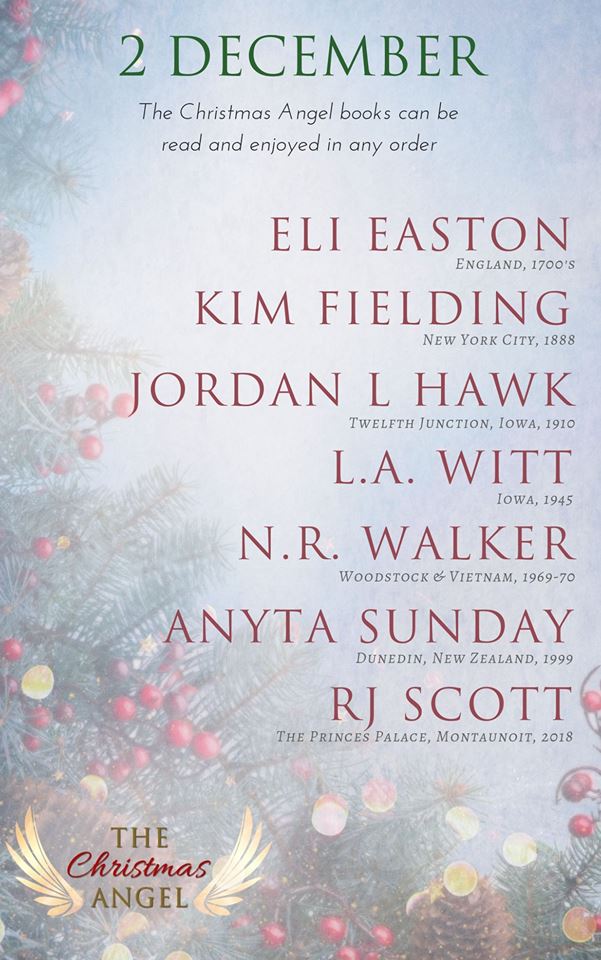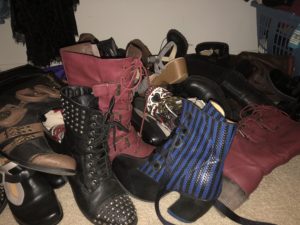I’m delighted to say that Andrew McFerrin has stopped by today! He’s narrated two of my books, Ante Up and The Little Library, and does really fantastic work.
Could you tell us a little about yourself?
How little are we talking? Ummm, I’m Andy, hi. Age 42, cis-gay dude, 6’4”, brown eyes, dark hair which I tend to keep shaved…I basically look like a biker. I’m the guy who walks into the homey local bakery cafe and there’s literally a moment of horrified silence—I can hear the record scratch in my head—as everyone wonders which violent crime I’m about to commit. And then I sit down, pull out a book, and order a spinach quiche and artisanal fair trade coffee or whatever. Defying expectations is hard work, but rewarding.
How did you start doing book narration?
Completely by accident, really. I was a guitarist and singer in a local rock band, and we recorded an album with John at Falcon Sound. The album didn’t turn out so great—we weren’t that good of a band—but I really get into the technical side of doing all that stuff. So in the process of pretending I knew something about EQs and compressors and what a noise gate is, John and I got to be pretty good friends. And the whole while he kept telling me about audiobooks he was doing, like “You should try this, you could make a living at it.” I never really thought much about it, kept putting the idea off. And then, one fairly minor financial upheaval later, I came back like “Yes, I do believe I shall try this. Tell me more of these audiobooks of which you speak…”
The weird thing was, I started getting work pretty much right out the gate. I think from the beginning of my first production to the part where I put in notice at my day job, it was like 6 months. So maybe I’m onto something…
I’d love to learn a little more about your process for narrating. Do you begin by reading the entire book to yourself before you start narrating? How long does an average novel take you?
Oh god yes. I can’t start narrating a book unless I know who’s who, how much of a role they’ll play, what kind of character arc they’re going through—I’ve tried to wing it exactly twice, and both times I ended up spending so much extra time and energy that I drove myself nuts. So yeah. Nothing happens until I’ve read the book and done preproduction, full stop.
After that the actual recording process takes maybe 8-10 working days for most books, then editing and all that stuff that basically makes it sound good. For every hour of narration, you can figure that about 6-7 hours of work have gone into it when all’s said and done.
How do you choose what kind of voice a particular character will have?
It’s always a process of deciding which details I want to focus on and to what extent. Big stuff like age, ethnicity, nationality, gender, species—straightforward obvious stuff. But also smaller details like attitude, how they relate to the world around them, and even what purpose they serve in the story. Like, a main character’s voice will probably be less affected because they have to express a greater emotional range, and the listener has to spend more time with them. Going back again to Ante, I knew that he needed a Slavic accent but I also knew that if I went overboard I’d lose all the other things a main character has to be able to do. Let’s face it, no one wants to hear a sex scene with Boris Badenov. But if it’s a smaller part I feel free to really cut loose and play.
I know I’m not exactly romanticizing my job the way I probably should, but that’s how I approach it. When I do my read I’m enjoying the story and getting into it, but in the back of my mind I’m also noticing those little details and character moments that I want to bring out. Most any time you hear me do something and think “Oh, that was cool,” it’s really just me calling attention to something cool that the author did. It’s really y’all’s show, I’m just the emcee.
What are some of the biggest challenges to doing narration work?
I live with cats, in a neighborhood inhabited by compulsive mowers of lawns.
What do you like to read for fun? Do you listen to audiobooks for fun too?
Just about anything! I love to hit the local Half Price Books and grab the first thing that looks interesting, and that’ll be my book for the week. I’m just finishing The Berlin Stories by Christopher Isherwood. If you’ve seen Cabaret, that’s the book it was based on. If you haven’t seen Cabaret, well…see Cabaret. But anyway, books. Physical books, used books, with spines and pages and sometimes other people’s grocery lists stuck in as a bookmark and forgotten about. That’s how I’ve always read for pleasure.
As for audiobooks…not for me. That’s work, you see. If I listen to someone else narrate, I’m too busy listening to what they did to follow the story. I can’t even watch TV shows with voiceover narration anymore, for that reason.
Do you have a dream project?
I don’t really think that way, to be honest. My idea of a dream project is a book where the themes or characters resonate so strongly with me that I just. Have. To. Do. It. And I’ve been lucky enough to have more than a few of those already—Ante Up was one, Brandon Witt’s Then the Stars Fall was another. On the non-romance front, I did this really wild SF novel about an autistic Amish boy who gets turned into a cyborg called Brother, Frankenstein. Most books have a couple scenes where the action plays out at a very emotionally-charged level, where I finish the scene and I’m completely drained. That book, the whole novel played that way. The protagonist was such a terrible person—I had so much fun getting to be him!
If money were no object, what vacation would you take right now?
Europe. All the Europe, I think. I’d start in Baku, on the Caspian Sea, head west until I hit Athens, then work my way north to Helsinki. Total walkabout, like a whole year. And then maybe I’d take the next year and work my way back down the western half, spend New Year’s Eve in Porto watching the sun melt into the sea through a wine glass.
What do you have in the works next?
Up next, I’m actually just starting production on the third book in the Knight & Day series by Dirk Greyson, for Dreamspinner. That’s pretty big fun, hunky secret agents and stuff. Can’t go wrong there.




















